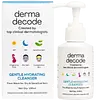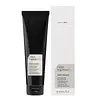What's inside
What's inside
 Key Ingredients
Key Ingredients

No key ingredients
 Benefits
Benefits

 Concerns
Concerns

 Ingredients Side-by-side
Ingredients Side-by-side

Betaine 2%
HumectantAloe Barbadensis Leaf Extract 1%
EmollientHyaluronic Acid 0.5%
HumectantCeramide AP 0.1%
Skin ConditioningWater
Skin ConditioningSodium Methyl Cocoyl Taurate
CleansingAcrylates Copolymer
Cocamidopropyl Betaine
CleansingSodium Lauroyl Sarcosinate
CleansingGlycerin
HumectantDecyl Glucoside
CleansingLauryl Glucoside
CleansingActinidia Chinensis Fruit Extract
EmollientErythritol
HumectantHibiscus Esculentus Fruit Extract
Skin ConditioningSodium Hyaluronate
HumectantPhenoxyethanol
PreservativeEthylhexylglycerin
Skin ConditioningTasmannia Lanceolata Fruit/Leaf Extract
AntioxidantDisodium EDTA
Citric Acid
BufferingCeramide NP
Skin ConditioningCeramide EOP
Skin ConditioningPhytosphingosine
Skin ConditioningCholesterol
EmollientSodium Lauroyl Lactylate
EmulsifyingCarbomer
Emulsion StabilisingXanthan Gum
EmulsifyingSodium Hydroxide
BufferingBetaine 2%, Aloe Barbadensis Leaf Extract 1%, Hyaluronic Acid 0.5%, Ceramide AP 0.1%, Water, Sodium Methyl Cocoyl Taurate, Acrylates Copolymer, Cocamidopropyl Betaine, Sodium Lauroyl Sarcosinate, Glycerin, Decyl Glucoside, Lauryl Glucoside, Actinidia Chinensis Fruit Extract, Erythritol, Hibiscus Esculentus Fruit Extract, Sodium Hyaluronate, Phenoxyethanol, Ethylhexylglycerin, Tasmannia Lanceolata Fruit/Leaf Extract, Disodium EDTA, Citric Acid, Ceramide NP, Ceramide EOP, Phytosphingosine, Cholesterol, Sodium Lauroyl Lactylate, Carbomer, Xanthan Gum, Sodium Hydroxide
Water
Skin ConditioningGlycerin
HumectantSodium Cocoyl Isethionate
CleansingBetaine
HumectantStearic Acid
CleansingGlyceryl Stearate Citrate
EmollientPentylene Glycol
Skin ConditioningDecyl Glucoside
CleansingDisodium Cocoamphodiacetate
CleansingCoconut Acid
CleansingSodium Lauroyl Glutamate
Juniperus Virginiana Oil
MaskingSclerotium Gum
Emulsion StabilisingSodium Isethionate
CleansingButylene Glycol
HumectantChlorphenesin
AntimicrobialPolyquaternium-10
Juniperus Communis Fruit Oil
MaskingSodium Chloride
MaskingSpinacia Oleracea Leaf Extract
Skin ConditioningPropanediol
SolventMyrtus Communis Extract
AstringentCarnosine
Skin ConditioningCoriandrum Sativum Seed Oil
EmollientLinalool
PerfumingLimonene
PerfumingCitric Acid
BufferingCedrus Atlantica Bark Oil
MaskingPelargonium Graveolens Oil
MaskingTephrosia Purpurea Seed Extract
Skin ConditioningElettaria Cardamomum Seed Extract
PerfumingSodium Benzoate
MaskingPotassium Sorbate
PreservativeJasminum Grandiflorum Flower Extract
MaskingWater, Glycerin, Sodium Cocoyl Isethionate, Betaine, Stearic Acid, Glyceryl Stearate Citrate, Pentylene Glycol, Decyl Glucoside, Disodium Cocoamphodiacetate, Coconut Acid, Sodium Lauroyl Glutamate, Juniperus Virginiana Oil, Sclerotium Gum, Sodium Isethionate, Butylene Glycol, Chlorphenesin, Polyquaternium-10, Juniperus Communis Fruit Oil, Sodium Chloride, Spinacia Oleracea Leaf Extract, Propanediol, Myrtus Communis Extract, Carnosine, Coriandrum Sativum Seed Oil, Linalool, Limonene, Citric Acid, Cedrus Atlantica Bark Oil, Pelargonium Graveolens Oil, Tephrosia Purpurea Seed Extract, Elettaria Cardamomum Seed Extract, Sodium Benzoate, Potassium Sorbate, Jasminum Grandiflorum Flower Extract
Ingredients Explained
These ingredients are found in both products.
Ingredients higher up in an ingredient list are typically present in a larger amount.
Betaine is a common humectant (a substance that promotes retention of moisture). It's known to be gentle on the skin and can help balance hydration.
This ingredient is best for improving hydration and soothing irritated skin. Studies also show it helps even out skin tone.
Fun fact: Betaine is naturally created in the skin and body. The kind found within cosmetic products can be either plant-derived or synthetic.
Another name for betaine is trimethylglycine.
Learn more about BetaineCitric Acid is an alpha hydroxy acid (AHA) naturally found in citrus fruits like oranges, lemons, and limes.
Like other AHAs, citric acid can exfoliate skin by breaking down the bonds that hold dead skin cells together. This helps reveal smoother and brighter skin underneath.
However, this exfoliating effect only happens at high concentrations (20%) which can be hard to find in cosmetic products.
Due to this, citric acid is usually included in small amounts as a pH adjuster. This helps keep products slightly more acidic and compatible with skin's natural pH.
In skincare formulas, citric acid can:
While it can provide some skin benefits, research shows lactic acid and glycolic acid are generally more effective and less irritating exfoliants.
Most citric acid used in skincare today is made by fermenting sugars (usually from molasses). This synthetic version is identical to the natural citrus form but easier to stabilize and use in formulations.
Read more about some other popular AHA's here:
Learn more about Citric AcidDecyl Glucoside is a glucose-based surfactant and emulsion stabilizer. It is created by reacting glucose with the fatty acids from plants.
Surfactants help clean the skin by trapping oil, sebum, and dirt to be washed away. As an emulsion stabilizer, it stabilizes the ingredients in a product by preventing them from separating.
This ingredient is biodegradable and non-toxic. This ingredient is commonly found in baby shampoos.
Decyl Glucoside is sometimes used to stabilize the UV filter Tinosorb.
Learn more about Decyl GlucosideGlycerin is already naturally found in your skin. It helps moisturize and protect your skin.
A study from 2016 found glycerin to be more effective as a humectant than AHAs and hyaluronic acid.
As a humectant, it helps the skin stay hydrated by pulling moisture to your skin. The low molecular weight of glycerin allows it to pull moisture into the deeper layers of your skin.
Hydrated skin improves your skin barrier; Your skin barrier helps protect against irritants and bacteria.
Glycerin has also been found to have antimicrobial and antiviral properties. Due to these properties, glycerin is often used in wound and burn treatments.
In cosmetics, glycerin is usually derived from plants such as soybean or palm. However, it can also be sourced from animals, such as tallow or animal fat.
This ingredient is organic, colorless, odorless, and non-toxic.
Glycerin is the name for this ingredient in American English. British English uses Glycerol/Glycerine.
Learn more about GlycerinWater. It's the most common cosmetic ingredient of all. You'll usually see it at the top of ingredient lists, meaning that it makes up the largest part of the product.
So why is it so popular? Water most often acts as a solvent - this means that it helps dissolve other ingredients into the formulation.
You'll also recognize water as that liquid we all need to stay alive. If you see this, drink a glass of water. Stay hydrated!
Learn more about Water